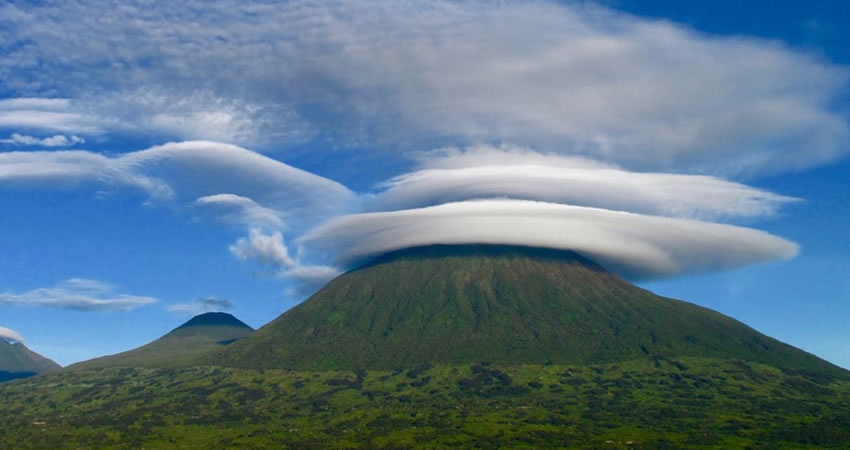Climbing Mount Karisimbi is one of the unmissable adventures in Volcanoes National Park. Mount Karisimbi is a 4,507-meter-tall Volcano along the border of Virunga National Park (Democratic Republic of Congo) and Volcanoes National Park (Rwanda), although it is mainly hiked from the latter. This inactive Volcano is the tallest of the 8 Volcanoes in the Virunga Massif and also the 11th tallest in the African Continent.
One of the things that makes this Volcano exceptional is the fact that it is covered by snow-like substances on its peak (even in the dry season). It is from these substances that the Mountain derived the name “Karisimbi” meaning “white shell” in the local Kinyarwanda dialect.

Views of Mountain Karismbi
Climbing Mount Karisimbi is one of the most popular hikes but is physically demanding, normally lasting 2 days to complete. This adventure is beyond hiking but is also a wildlife viewing opportunity along the way (especially to see primates and bird species). Climbing this spectacular Volcano is also a great chance to learn about the life and works of Dian Fossey, the American Primatologist who dedicated about 2 decades of her life to researching the mountain gorillas in Volcanoes National Park before her tragic murder in 1985.
How Mount Karisimbi Climbing is done
This two-day hike normally begins at Kinigi Park Headquarters (in Volcanoes National Park) with a briefing from the park Rangers on what to expect, duration, and other important details. On the first day of the hike, you will have a 7-8-hour ascent until an altitude of about 3700 meters above sea level. This is surprisingly just mid-day the hike and a Tent will be pitched at this point for overnight Camping and dinner.
The remaining part of the Mount Karisimbi ascent will be done the next day when you are stronger because it gets tougher as you ascend. Start your second day with a cup of tea/coffee prepared by porters (who have to be hired in advance). Complete the final leg of your ascent whereby you will be treated to steeper terrains, sometimes muddy trails, and fog on the peaks (which will sometimes affect visibility). Enjoy views, relax, and begin the 6-hour descent to the starting point with several stops to hydrate and spot different wildlife species.
How much is it to climb the Mountain?
Climbing Mount Karisimbi costs $400 per person per day, and only includes the hike, Ranger fee, and overnight Camping. Additionally, you will need to hire a porter/s at about $20 per person per day to help with your backpack and offer support during the strenuous hiking adventure.
What to pack for Mount Karisimbi Climbing Adventure
What you choose to/not to Pack during your Mount Karisimbi climbing adventure will affect your overall experience. Therefore, don’t forget a rainproof and lightweight rain jacket, warm sweaters for the cold mornings and evenings, a safari hat, sunglasses, sturdy hiking boots with enough grip, gaiters, cotton socks, gardening gloves, camera equipment (extra lenses, batteries, and others), comfortable safari pants, long-sleeved shirts, Camping equipment (warm beddings, tent, sleeping bag, and blanket) but these can be hired from the starting point, a first aid kit, a reusable water bottle, a pair of binoculars, an insect repellant, energy giving snacks, and some toiletries (especially your toothbrush, toothpaste, lotion, sunscreen, hair comb/brush, and others).
When is the best time to climb the mountain?
While climbing Mount Karisimbi is an all-year adventure, the dry months of January, February, June, July, August, September, and December are considered to be more favorable for a number of reasons. First, the white-shell on the peak of Mount Karisimbi can be clearly seen during these months unlike in the wet months that are marked by fog hence affecting visibility.
Also, there are reduced precipitation levels in the dry season, which means forest trails are less muddy and slippery.
Besides Mount Karisimbi, visitors to Volcanoes National Park can climb Mount Bisoke, which is usually done in 6-7 hours only for a round trip. There is also the famous Rwenzori Mountain ranges and Mount Elgon in the neighboring Uganda.
